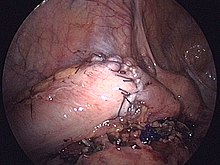Medical Uses of Surgical Anastomosis
- Blood vessels: Arteries and veins require anastomoses for vascular procedures such as bypass operations, aneurysmectomy, and organ transplants.
- Gastrointestinal (GI) tract: Anastomoses are necessary for restoring continuity after elective resections of organs like the esophagus, stomach, small bowel, large bowel, bile ducts, and pancreas. Bariatric surgery relies on bypass operations.
- Urinary tract: Anastomosis is required in procedures like radical prostatectomy and radical cystectomy to restore continuity between the bladder and urethra.
- Microsurgery: Microsurgical techniques have enabled anastomoses previously considered impossible, including nerve anastomoses and fertility restoration after tubal ligation or vasectomy.
- Anastomotic leak: The success of a surgical procedure often depends on the complex and time-consuming step of creating an anastomosis.
Related Techniques
- Urinary diversion: Related technique used in surgical procedures.
Research Studies
- Vilhjalmsson et al. (2015). The Compression Anastomotic Ring-Locking Procedure: A Novel Technique for Creating a Sutureless Colonic Anastomosis.
- Höglund et al. (2017). A self-locking loop as an alternative to purse-string suture in colon anastomosis: a feasibility study.
A surgical anastomosis is a surgical technique used to make a new connection between two body structures that carry fluid, such as blood vessels or bowel. For example, an arterial anastomosis is used in vascular bypass and a colonic anastomosis is used to restore colonic continuity after the resection of colon cancer.

A surgical anastomosis can be created using suture sewn by hand, mechanical staplers and biological glues, depending on the circumstances. While an anastomosis may be end-to-end, equally it could be performed side-to-side or end-to-side depending on the circumstances of the required reconstruction or bypass. The term reanastomosis is also used to describe a surgical reconnection usually reversing a prior surgery to disconnect an anatomical anastomosis, e.g. tubal reversal after tubal ligation.